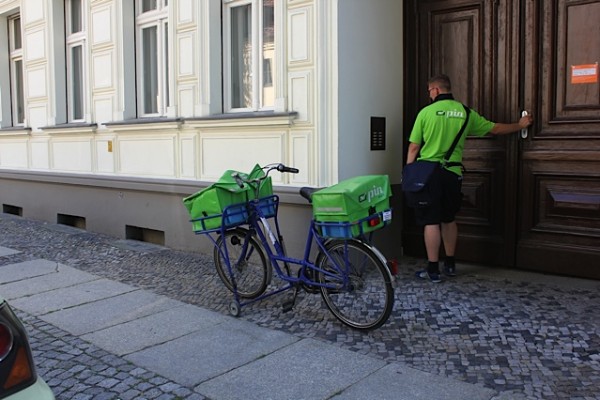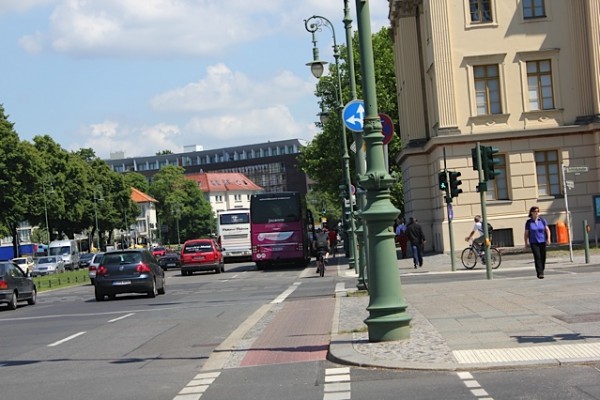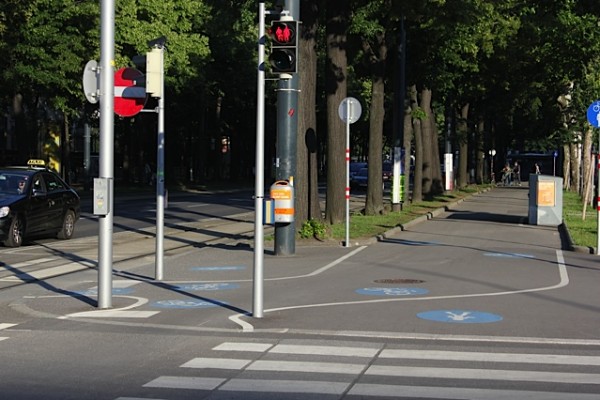This post by Beth Savan, the Principal Investigator of the Toronto Cycling Think & Do Tank & is part of Spacing‘s partnership with the Think and Do Tank at the University of Toronto. Find out more about it here.
We’ve come to think of Europe, with its dense urban form, high gas prices and cafe culture as a lovely place to ride a bike. Cycle tracks abound, men and women ride across broad age groups, and they feel so safe people rarely wear helmets. On a recent visit however, I found that understanding European cycling wasn’t as simple as these enviable indicators, and there’s no one approach to cycling when we link cities or cross cultures. The result is a diversity of approaches each with their own range of cycling mode shares that, while generally higher than in North America, still provide important insights into how we can build cycling friendly cities here across the Atlantic. When my travels allowed me to compare Berlin against Vienna I found more surprises than I could have expected: The first being my love for Berlin. 
After a day on two wheels, I knew I’d found my cycling heaven. In a city in transition, with more construction than even we Torontonians can imagine, bikes, pedestrians, trams, buses, cars and trains all share the road in a polite and tolerant manner. I suppose I shouldn’t be surprised. For a large (3.4 million in 2010) dense city, with apartment buildings of 6 or 7 stories as the norm, and with commercial and institutional destinations scattered around the city, cycling is simply the fastest and most pleasant way to get to places within easy reach.
Bikes are everywhere, and they are as varied as their riders, from fixies and the odd road bike to mountain bikes and the dominant steel city bikes with fat tires that defy the skinny tram tracks. We saw old folks, young kids, businessmen in suits, elegant fashion plates and everything in between, casually weaving through the urban fabric. Bikes are available for rent in hotels, cafes, on street corners, and from the city bike share system. But it doesn’t stop there. If you buy an up-cycled bag at the Freitag store, you get free use of a fixie during your stay! Mostly, cyclists move pretty slowly. But no one is moving very fast. Cars, trams and buses are all restricted by an urban speed limit of 30 km/hr that hits its max at 50 km/hr. on arterials. So even when everyone is jumbled together on narrow streets often cordoned off for construction, it feels perfectly pleasant and safe. Most people don’t wear helmets and I certainly didn’t feel naked without one, as I would at home.
What exactly makes Berlin cycling such a joy? First, there seems to be a hierarchy of rules and infrastructure. Larger roads feature non-separated lanes, mostly on sidewalks with distinct paving or painted onto the roadway and clear intersection protocols. Smaller roads descend into apparent chaos, where everyone manages to get to their destination helter-skelter. While travelling, people yield to pedestrians, bikes, trams, busses and cars, in that order. So, even when cyclists make a bad move on the road, or pedestrians wander onto sidewalk cycle paths, there is no problem as everyone else accommodates them.
Second, public transportation is convenient and extensive, with subways, above ground trains including both local and express lines, articulated streetcars or trams, with two or three connected cars, as well as buses (and pedicabs) connecting all these systems. Deliveries are made by bike as well as by vans, and people walk a lot. The public transport (26%) and pedestrian (29%) mode shares permit a healthy cycling one (13%), leaving only 32% of the trips to be made by car. Finally, the abundance of bike parking at transit stations attests to the popularity of multi-modal travel for longer distances. This magical combination will enchant you.
The next leg of my travels was equally surprising. Vienna, a city of 1.7 million, with 1,200 km. of bike lanes and two city bike loaner schemes, governed by a green/ social democratic alliance should add up to an ideal cycling city. It was a shock to discover that cycling it actually left a lot to be desired.
The city spruced up its infrastructure in preparation for the Velo-City conference mid-June and the accompanying influx of 1,200 cycling enthusiasts from around the world. And this infrastructure and conference related events ran the gamut: brightly painted white lines and logos indicating where cyclists should situate themselves, a cyclist counter on a central roundabout, cycling art exhibitions, a fashion show and a bike bell concert. Conference delegates were given free bikes and bike route maps showing the extensive network of lanes, sharing the sidewalk or roadways.
But in spite of the number of bikes (mode share is 5%), paths and services per citizen, cycling in Vienna was not much fun. Drivers moved very quickly and pedestrians were not good at sharing space on joint pathways. On more than one occasion, I was yelled at by pedestrians, other cyclists and drivers, usually for mysterious infractions of invisible rules. Cycle tracks are frequently interrupted by dedicated pedestrian paths, creating confusion and tension. These tracks have clearly been retrofitted onto sidewalks, and often involve very sharp turns, requiring cyclists to either cut tight corners or reduce speeds. Paths shared between cyclists and pedestrians are labeled in such a way that they appear to slalom back and forth. Collisions are not uncommon, according to the cycling advocate/lawyer who led our conference tour of cycling infrastructure that had prompted collisions and then litigation. The overwhelming impression is one of infrastructure that attempts to cram each travel mode into its own small space, with every group resenting the others next to it.
So what can we learn for Canadian cities? The main lesson is that tolerance and civility are critical for happy mobility. Socially accepted shared space (with appropriate rules, signage and speed limits) on narrow roads or sidewalks trumps separate lanes that are too narrow, and impossibly sharp turns must be avoided. Separated infrastructure can be a wonderful asset for cyclists- but only if it is done right-all separated lanes are not equal. And, finally the benefits of getting people onto bikes and out of cars on congested roads and crowded transit vehicles need to be emphasized to everyone.
More cycling makes transit and driving much more pleasant and efficient. We’re all in this together. All modes need to work well to permit the choice of a travel method that works best for a specific trip. More cycling clears space for others, and reduces our collective tax burden for health care, defers costs for road maintenance and transit vehicle purchases and increases revenues for businesses on roads with cycle paths. Most importantly, more cyclists means safer cyclists, as accident rates decline with increasing cycling mode share.
Needless to say, I’ll be returning to Berlin for a longer visit to enjoy a city with art, music, great food and cafes, fabulous design and architecture and a vibrant cycling culture that takes two wheels for granted as a pivotal component of a very livable city. A return to Vienna will require some convincing, despite the outstanding Wiener schnitzel and pastries!






One comment
Berlin also has terrible shared sidewalks with countless obstacles and interruptions for cyclists. Vienna has a big problem with cars parking in bike lanes/blocking cycle track entrances.